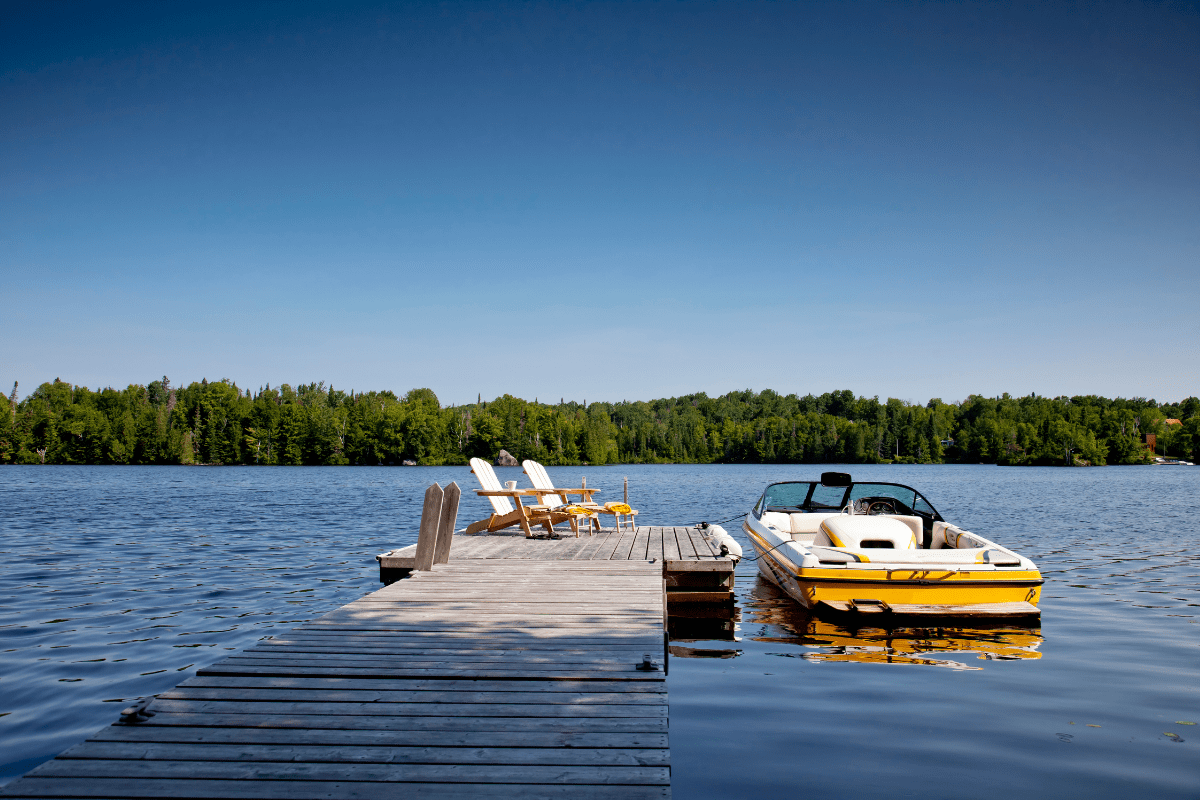Michigan's relationship with water borders on the ridiculous. With over 11,000 inland lakes and 3,288 miles of Great Lakes shoreline, you literally can't escape water here if you tried… no point in the state sits more than six miles from a lake or 85 miles from a Great Lake.
The numbers that'll make your jaw drop
Let's start with the mind-blowing statistics that make Michigan utterly unique among U.S. states. The Great Lakes surrounding Michigan contain 21% of the world's fresh surface water, which sounds impressive until you realize that's enough water to cover the entire continental United States to a depth of 9.5 feet. Michigan claims more Great Lakes shoreline than any other state, including 1,056 miles of island shoreline that most people forget to count.
The economic impact reaches staggering proportions too. Michigan's water-based tourism generates $54.8 billion annually while supporting 351,292 jobs. That's not a typo… over 350,000 people make their living thanks to Michigan's lakes. About 131.2 million visitors flock to Michigan's waters each year, which means the lakes attract more annual visitors than Disney World, Yellowstone, and the Grand Canyon combined.
Beyond the well-known figure of 11,000 lakes (which only counts bodies of water five acres or larger), Michigan harbors thousands of smaller ponds and wetlands. The state touches four of the five Great Lakes: Superior, Michigan, Huron, and Erie. Only Ontario escapes Michigan's watery embrace, probably feeling a bit left out at Canadian parties.
Where to actually go: The lakes worth driving for
The inland gems that locals guard jealously
Torch Lake stretches 19 miles through Antrim County, making it Michigan's longest inland lake. Its Caribbean-blue waters reach depths of 310 feet, and yes, everyone will tell you it looks like the Caribbean, and yes, they're actually right. The spectacular turquoise color comes from limestone deposits, not some Michigan tourism board conspiracy involving food coloring.
Houghton Lake claims the title of Michigan's largest inland lake at 20,044 acres, though calling it a lake feels generous when the maximum depth barely hits 35 feet. You could probably walk across parts of it if you're tall enough and don't mind wet socks. Still, the shallow waters warm up beautifully in summer, making it perfect for families with young kids who haven't quite mastered swimming yet.
Here's my personal ranking of must-visit inland lakes:
- Higgins Lake (crystal clear waters)
- Crystal Lake near Frankfort (see-your-toes-at-10-feet clear)
- Lake Charlevoix (three distinct basins)
- Glen Lake (actually two connected lakes)
- Black Lake (massive northern pike)
- Lake St. Clair (world-class bass fishing)
- Burt Lake (perfect for sailing)
The Great Lakes spots that actually live up to the hype
Sleeping Bear Dunes National Lakeshore earned its title as "Most Beautiful Place in America" from Good Morning America, and honestly, they weren't wrong. Those 450-foot sand bluffs overlooking Lake Michigan will absolutely destroy your legs if you run down and try to climb back up, but the view makes the cardiac event worthwhile.
Holland State Park somehow attracts over 2 million visitors annually to see Big Red lighthouse and enjoy the beach. Pro tip: arrive before 9 AM in July or prepare to park in Indiana. Warren Dunes State Park offers three miles of Lake Michigan shoreline with 182 campsites that book up faster than Taylor Swift tickets.
Silver Lake State Park remains Michigan's only park that lets you drive ATVs on sand dunes… 3,000 acres of them. It's basically a giant sandbox for adults with expensive toys and questionable decision-making skills.
Your complete Michigan fishing guide (without the fish tales)
What it'll cost you
Michigan's fishing industry contributes $2.3 billion annually to the state economy, and they'd like some of that to come from your wallet, thank you very much. Here's the current damage to your bank account:
- Resident annual license: $26
- Non-resident annual: $76
- Senior citizens (65+): $11
- Free fishing weekend: February 18-19, 2025
The state stocks an absolutely bonkers 9.7 million fish annually, including 590,504 fish weighing 10.7 tons in fall 2024 alone. That's a lot of future fish fries swimming around out there.
Where the fish actually bite (sometimes)
Lake St. Clair has been crowned by Bassmaster magazine as potentially the world's best smallmouth bass fishery, which is quite the claim considering the world is pretty big and has lots of water. Saginaw Bay offers the premier winter walleye fishery in the Great Lakes, though "premier" in January means "really freaking cold."
For ice fishing enthusiasts who enjoy sitting on frozen water in subzero temperatures (there are dozens of us!), Lake Gogebic in the UP provides early ice for walleye, northern pike, and perch. Cass Lake near Detroit offers accessible jumbo perch for those who prefer their hypothermia risk within driving distance of a Starbucks.
New regulations for 2025 include a 50-inch minimum size for muskellunge on Thornapple Lake and Lake Hudson, because apparently the fish weren't big enough to give anglers heart attacks before. Chinook salmon in Lake Michigan have been hitting the gym in reverse, dropping from average weights of 20 pounds in 2018 to about 17 pounds currently, blamed on declining alewife populations. The salmon are basically on an involuntary diet.
Upper Peninsula vs Lower Peninsula: Two different worlds
The UP: Where cell service goes to die
The Upper Peninsula packs 4,300 inland lakes into just 29% of Michigan's land area, achieving a lake density that would make Minnesota jealous. Only 3% of Michigan's population lives up here, which means you'll have plenty of lakes to yourself, assuming you can find them without GPS.
Lake Superior's water temperature rarely exceeds 65°F even in shallow areas during summer. That's not refreshing; that's hypothermia with a view. The entire UP sits on Precambrian Shield rock that's 3.5 billion years old, creating dramatic features like Pictured Rocks where 200-foot multicolored cliffs tower above Superior for 42 miles.
The UP also boasts over 40 lighthouses, presumably because ships kept running into things in the dark back before GPS and common sense were invented.
The Lower Peninsula: Civilization meets water
The Lower Peninsula contains most of Michigan's inland lakes within 71% of the state's area, conveniently serving 97% of the population who prefer their wilderness experiences with nearby wifi. Lake Michigan's summer surface temperatures reach a actually-swimmable 68-75°F from June through September, allowing normal humans to enter the water without immediately regretting their life choices.
Northwest Michigan's resort communities like Traverse City, Charlevoix, and Holland have mastered the art of extracting tourist dollars while maintaining that "quaint small town" vibe. Torch Lake's massive sandbars become floating parties every summer weekend, where boats raft together in a display of maritime chaos that somehow rarely ends in disaster.
When to visit (and when to run away)
Summer: Peak chaos season
July and August bring perfect swimming weather and approximately 47 million other people with the same idea. Torch Lake's sandbars transform into aquatic block parties. Every state park campground fills up faster than you can say "reservation system," and boat launches become entertaining displays of backing-up incompetence.
Top summer activities that won't make you homicidal:
- Early morning kayaking (before noon crowds)
- Sunset beach walks (after families leave)
- Weekday anything (avoid weekends like plague)
- Hidden inland lakes (shhh, don't tell)
- Night fishing (peaceful and productive)
Winter: For the genuinely brave
Ice fishing season runs December through March on over 4,000 frozen inland lakes. Saginaw Bay's ice typically becomes safe (relatively speaking) from mid-January through March, offering eight-fish daily walleye limits to anyone willing to drill holes in frozen water for fun.
Ice shanties must display owner information, presumably so authorities know who to notify when you fall through. Southern Michigan shanties must vanish by March 15, while northern regions get until March 31, because apparently fish up north are more patient.
The environmental stuff nobody wants to talk about
Invasive species: The unwanted guests
Michigan's lakes face an invasion of 180+ non-native species that make themselves at home like that cousin who "just needs to crash for a few days" and never leaves. Zebra and quagga mussels top the Most Unwanted list, having fundamentally altered lake ecosystems since arriving via ship ballast water in the 1980s.
The $1.1 billion Brandon Road project began construction in 2024 to keep Asian carp out of the Great Lakes using electric barriers, acoustic deterrents, and what I imagine are very sternly worded signs. The barriers should prevent 99% of carp access, though that remaining 1% keeps biologists awake at night.
Water quality: It's complicated
The 2024 algae bloom season hit record levels with 92 confirmed harmful blooms statewide. Lakes infested with zebra mussels show three times higher toxic algae levels because the mussels eat the good algae and spit out the bad stuff. They're basically the aquatic equivalent of a picky toddler.
PFAS contamination potentially affects 3.2 million Michigan residents' water sources. Tawas Point recorded 7,900 parts per trillion PFAS in Lake Huron foam, compared to drinking water limits of 8ppt. That's nearly 1,000 times the safe level, which seems… not great.
Climate change isn't helping either. Lake Michigan's deep waters are warming while "winter is vanishing," according to NOAA researchers. Ice cover on New Year's Day 2024 hit 50-year lows, and projections show water levels rising 0.44 meters by 2040-2049.
Maritime history for nerds (and everyone else)
Michigan's waters hide an estimated 1,500 shipwrecks, part of 6,000+ vessels lost across the Great Lakes. The SS Edmund Fitzgerald remains the most famous, sinking in 1975 with all 29 crew members. Its recovered bell now sits at Whitefish Point's Great Lakes Shipwreck Museum, attracting 100,000 annual visitors who come to feel sad about boats.
The state maintains 150+ lighthouses, more than any other state because apparently we really didn't want ships hitting things. Big Sable Point Lighthouse made Weather Channel's top 10 U.S. lighthouses list, while Holland's "Big Red" claims the title of Michigan's most photographed lighthouse, though I'm pretty sure nobody actually counts these things.
Thunder Bay National Marine Sanctuary protects 116 wrecks in 448 square miles, offering glass-bottom boat tours for wimps like me who prefer viewing shipwrecks while remaining dry. Thirteen underwater preserves protect 2,300 square miles of lake bottom, with actual felony penalties for removing artifacts because some people can't help themselves.
The investment reality check
Michigan poured $1.7 billion into water infrastructure in 2024, addressing everything from lead pipes to stormwater management. The Great Lakes Restoration Initiative's $450 million for 2025 promises $3.35 in economic return per dollar spent, according to University of Michigan research that definitely wasn't biased at all.
The lakefront property market exceeds $2 billion in total value, with 624 current listings averaging $764,815. That's a lot of money for the privilege of dealing with erosion, flooding, and geese. The Pure Michigan campaign generated $1.3 billion in visitor spending, proving that cheesy tourism slogans actually work sometimes.
Personal watercraft owners spend $430 annually on their lake toys, while luxury boat owners drop $5,039, presumably on gas alone. The state's "Michigan the Beautiful" initiative aims to conserve 30% of waters and lands by 2030, which sounds ambitious until you remember Michigan is basically already 30% water.
Your action plan for Michigan lakes
Look, Michigan's lakes aren't going anywhere (despite climate change's best efforts), but the good spots fill up fast and the fish don't always cooperate. Book state park campgrounds at least three months ahead for summer weekends. Get your fishing license online before driving three hours to find out the bait shop's card reader is broken. Check ice conditions with locals, not Facebook, unless you enjoy swimming in January.
The lakes define Michigan more than cars, cherries, or even our adorable Michigan-shaped mittens we use as hand maps. Whether you're into fishing, swimming, boating, or just staring at water while questioning your life choices, Michigan's got a lake for that. Just remember to respect the water, pick up your trash, and don't be that person who can't back up a boat trailer. Nobody likes that person.





